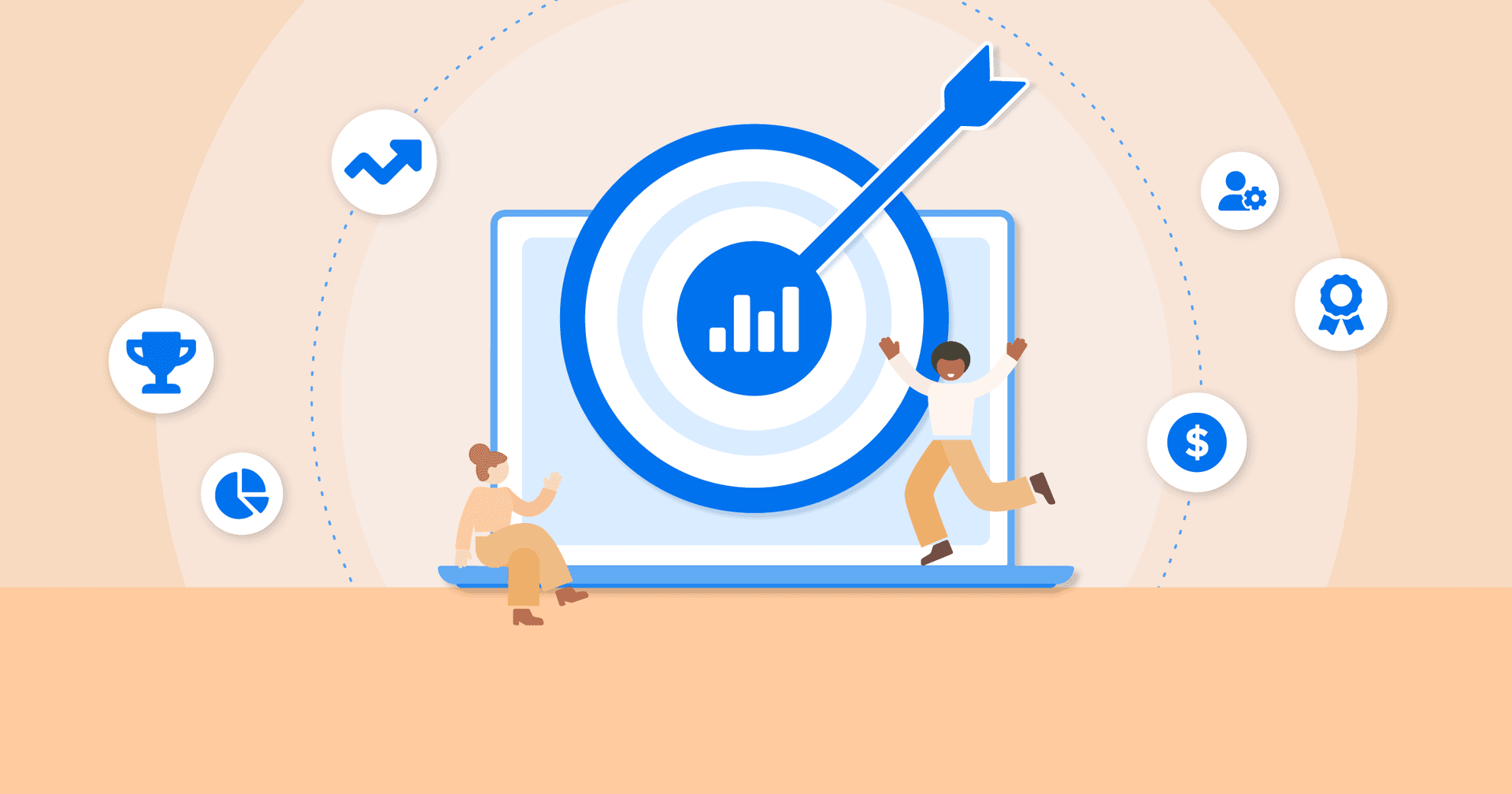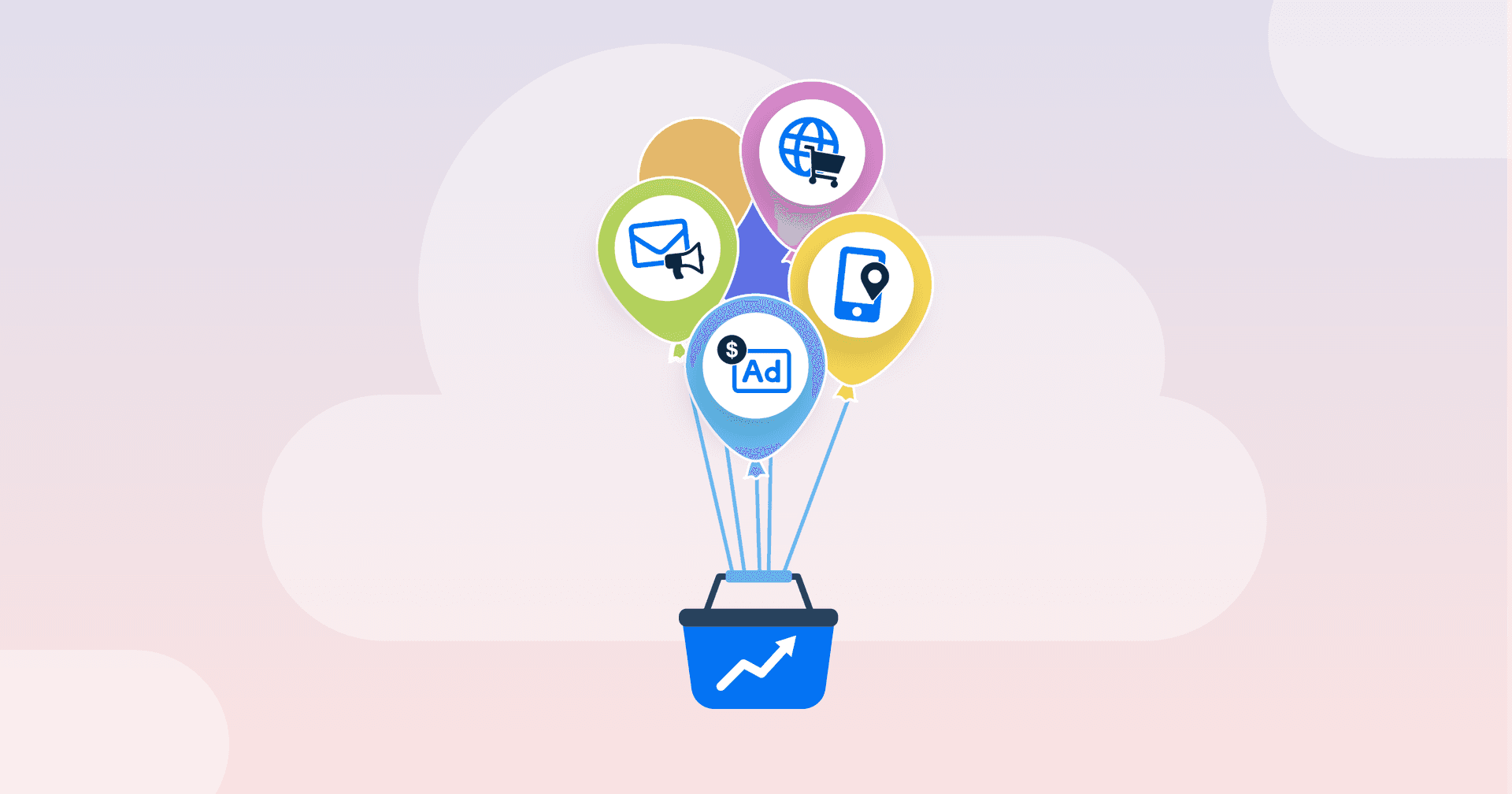Table of Contents
Table of Contents
- What is Data-Driven Marketing?
- The Benefits of Data-Driven Marketing
- Why Data-Driven Marketing is Becoming More Important Than Ever
- Data-Driven Marketing vs. Traditional Marketing
- Common Data-Driven Marketing Tools
- How To Build a Data-Driven Marketing Strategy
- 3 Data-Driven Marketing Examples for Inspiration
- Data-Driven Marketing Works
7,000+ agencies have ditched manual reports. You can too.
Free 14-Day TrialQUICK SUMMARY:
Smart agencies don’t rely on intuition—they analyze data and use insights to drive every decision. A data-driven marketing strategy helps marketing teams identify the most effective marketing channels, messaging, and target audience, ensuring maximum ROI for every client campaign. In this article, we’ll share how to leverage data into actionable insights that fuel smarter strategies and bigger wins.
Your agency collects a goldmine of data every day—from ad performance to website traffic, engagement metrics, conversion rates, and more. Buried in all of that marketing data are insights that could set your agency apart. The question is: Are you using your marketing data to its fullest potential, or are you just scratching the surface?
Data-driven marketing is about turning data insights into action. When your agency takes this approach, you start consistently optimizing campaigns in a way that drives real growth.
In this article, we’ll cover why data-driven marketing is essential for agency success, the best data collection and analysis tools, and actionable steps to build a data-driven strategy from scratch.
What is Data-Driven Marketing?
Data-driven marketing is a marketing approach that bases decision making on customer data rather than creative intuition.
Think of it this way: Instead of guessing what your client’s customers want, you collect and analyze a wealth of data—everything from browsing habits and purchase history to social media interactions and survey feedback.
After analyzing the data, you’re then able to make informed decisions on facts, not hunches! The result is more personalized campaigns that resonate more strongly with your client’s target audience and deliver better outcomes.
The Benefits of Data-Driven Marketing
Is making data based decisions all that important for marketing teams?
Absolutely—The most successful agencies aren’t just running better campaigns—they’re also proving their value, driving higher ROI on client marketing investment, and securing long-term client relationships.
Here’s why building a data-driven strategy gives your agency a competitive edge:
Maximized Efficiency: Stop wasting time and budget on guesswork. Decision making based on evidence means focusing on high-impact strategies instead of trial and error. The result? Less wasted ad spend and more predictable, scalable success.
Deeper Customer Insights: Marketing data reveals what truly resonates with your audience, allowing you to refine messaging, personalize offers, and create content that drives higher engagement and conversions.
Greater Agility: Real-time analytics give data-driven marketers instant visibility into what’s working and what’s not. By breaking down data silos and unifying marketing insights, you’re able to quickly pivot strategies, optimize underperforming campaigns, and improve results before budgets are wasted.
Stronger Client Retention: Clients expect proof that their marketing dollars are working. When you consistently deliver data-driven insights and measurable wins, you reinforce your value and keep clients invested for the long haul.
Elevated Agency Positioning: Data-driven agencies go beyond the bare minimum of running campaigns and provide strategic guidance. Offering data-backed recommendations helps you position your agency as a growth partner, not just another service provider.
New Growth Opportunities: Predictive analytics empowers marketing teams to forecast trends, seize market opportunities early, and fine-tune offerings for maximum profitability.
In a nutshell, data-driven marketing is about working smarter, not harder!
Why Data-Driven Marketing is Becoming More Important Than Ever
Why is data driven marketing important today? Well, the agency world has never been more competitive—and AI tools are only accelerating the pace. New tools are emerging daily, giving data-driven agencies a massive advantage over those still relying on intuition. If you’re not leveraging AI-powered insights, real-time analytics, and predictive modeling, your competitors already are.
Data is the foundation of every high-performing campaign. Leading agencies aren’t just reacting to trends; they’re anticipating them too. AI tools now allow marketing teams to monitor campaigns in real-time, instantly identify what’s working (and what’s not), and optimize performance before budgets are wasted. More importantly, predictive analytics help forecast customer behavior, allowing them to shape strategies proactively instead of scrambling to catch up.
Agencies that embrace data don’t just survive—they dominate. The ability to analyze data, adapt quickly, and make informed decisions is what separates top-performing agencies from those struggling to stay relevant.
Data-Driven Marketing vs. Traditional Marketing
The biggest difference between traditional and data-driven marketing is how decisions are made.
Traditional marketing relies on instinct and experience to determine strategies, which may lead to wasted ad spend if assumptions are off. Data-driven marketing uses real evidence to guide decisions, ensuring every dollar is spent more effectively.
Take seasonal trends, for example. A traditional strategy might assume “Summer is always slow” and scale back ad spend. But without data, that move could be costing you revenue.
A smarter, data-driven approach would analyze past performance and uncover insights like: “Traffic stays steady in July and August, but conversion rates typically drop by 17%.” With that information, you could shift your strategy—testing new offers, refining ad targeting, or reallocating budget to higher-performing channels—instead of just accepting the slowdown.
Both approaches recognize a seasonal slowdown, but only the data-driven marketing strategy provides the precise what and why, allowing for smarter, more effective decision-making.
To better illustrate the difference between traditional marketing approaches and data-driven approaches, let’s examine two popular marketing channels:
Data-Driven Email Marketing vs. Traditional Email Marketing
Traditional email marketing often feels like a guessing game—marketing teams send campaigns at times that seem right and hope for the best. But hope doesn’t drive results.
A data-driven approach eliminates guesswork in email marketing. Analyzing KPIs like open rates, click-through rates, and other customer behavior metrics lets you pinpoint precisely what works and what doesn’t.
Want to know the best time to send an email? The data tells you when your audience is most likely to engage. Not sure if your subject line will perform? A/B testing provides the answer.
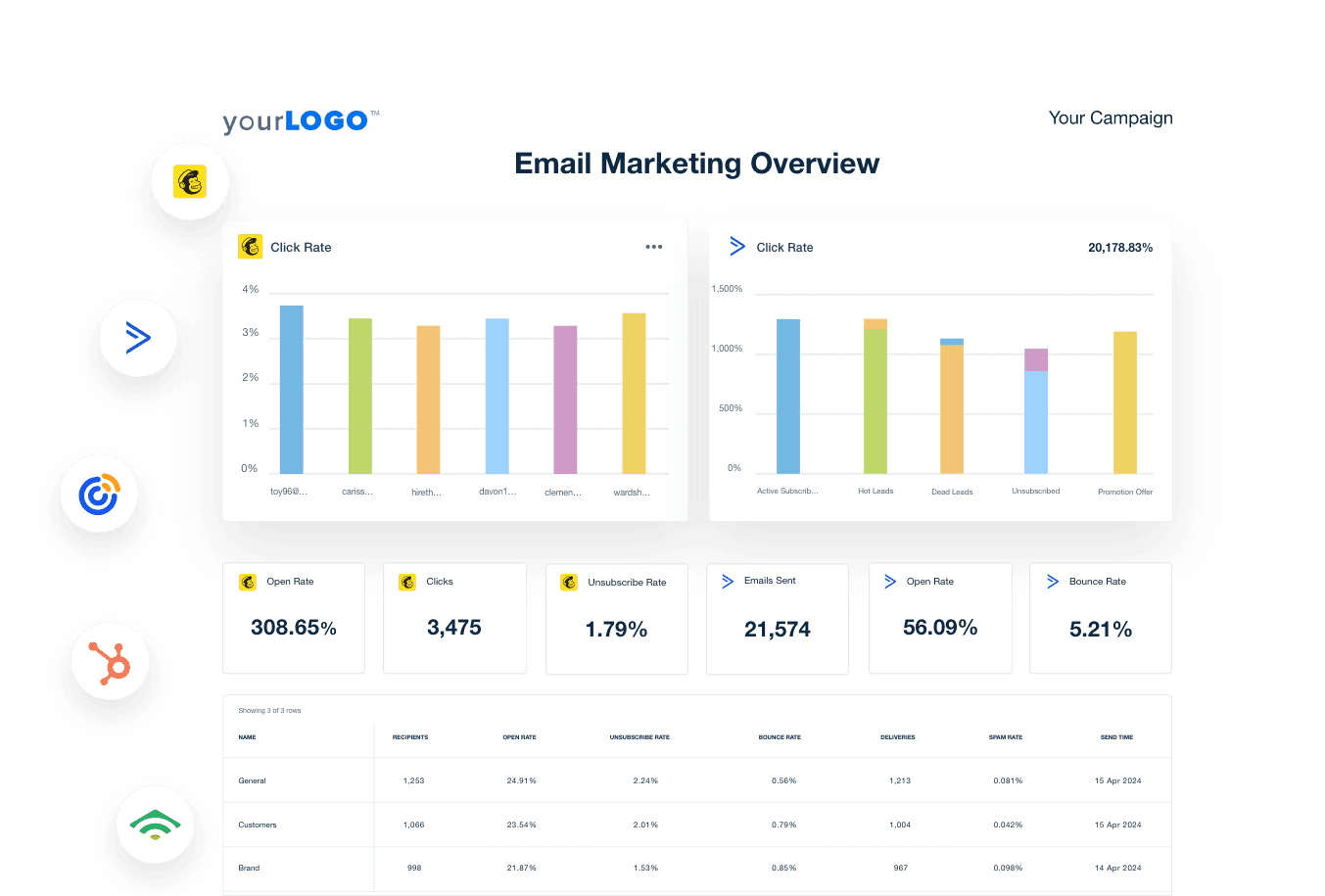
Optimize client campaigns with email insights using AgencyAnalytics’ email marketing dashboards and ensure every email hits the mark. Start your 14-day free trial.
Data-Driven Social Media Marketing vs Traditional Social Media Marketing
The same thing goes for social media. Success on social media platforms comes from knowing what works and doubling down. Yet, too many marketing teams still chase trends or assume content will resonate based on what feels right.
Data-driven campaigns change the social media game. The right data shows you when your followers are most active, which types of posts drive the highest interaction, and which platforms generate the best ROI.
With this insight, you’re not just posting—you’re strategically optimizing every piece of content and ad to maximize reach, engagement, and conversions.
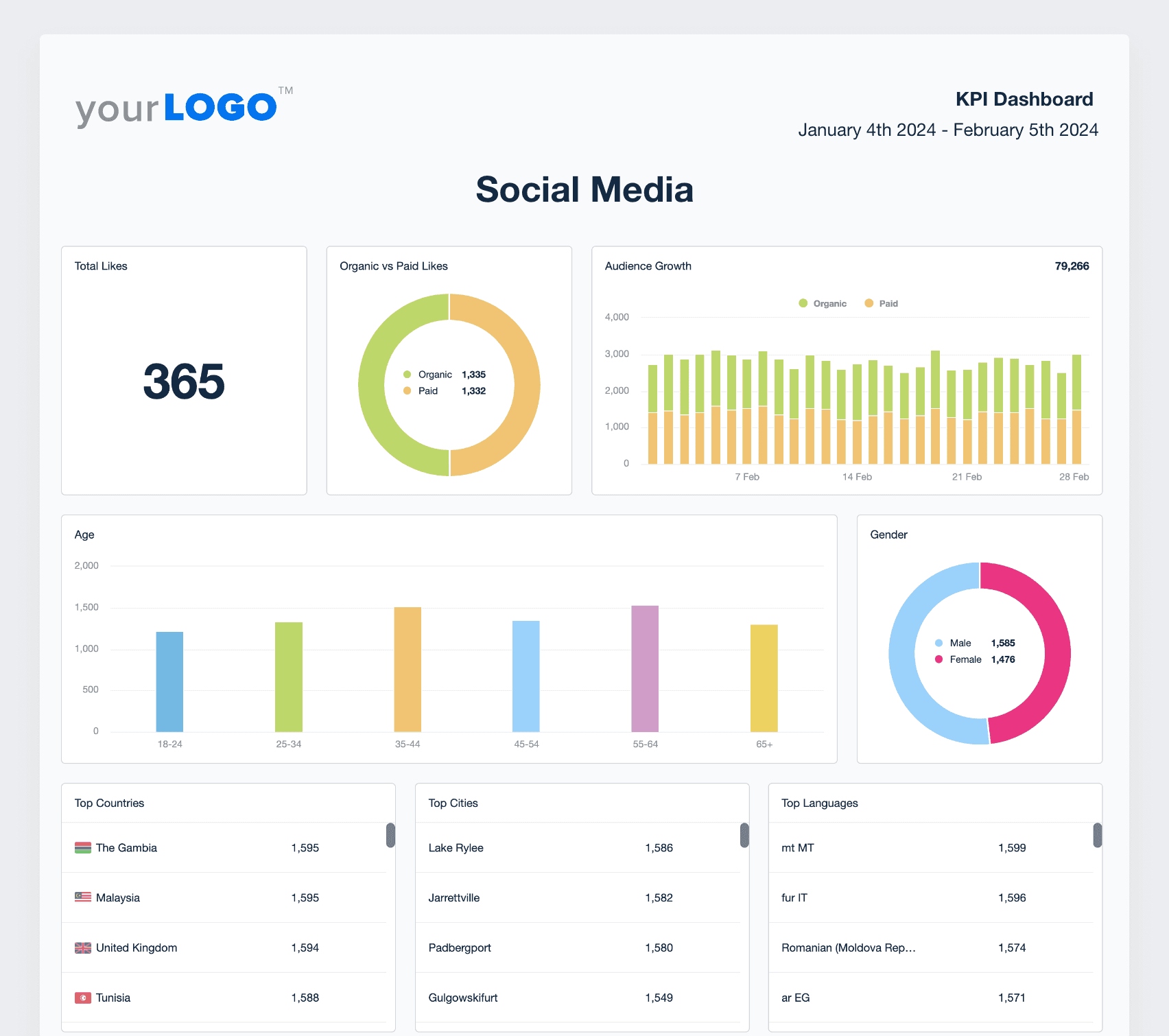
Transform social media data into smarter strategies with AgencyAnalytics’ social media dashboards. Track performance, optimize content, and boost engagement. Start your 14-day free trial.
Common Data-Driven Marketing Tools
The most important thing is to have the right tools in your agency’s tech stack. Here is a list of tools to help you collect, analyze, and visualize data more efficiently.
Software Type | Uses | Popular Tools |
|---|---|---|
Data Analytics Tools | Deliver a clear picture of website traffic, audience behavior, and campaign performance. Help track key metrics and uncover insights to refine your strategies. | AgencyAnalytics, Google Analytics 4, Adobe Analytics, Clicky, Matomo |
Customer Relationship Management (CRM) Systems | Centralize client data, track interactions, and personalize marketing efforts to improve engagement and retention. | Salesforce, HubSpot, Zoho, Pipedrive |
Marketing Automation Platforms | Automate repetitive tasks like email sequences, social media posts, and ad targeting to save time and improve consistency. | HubSpot, Marketo, Pardot, ActiveCampaign |
Data Visualization & Reporting Tools | Turn raw numbers into clear, actionable insights that clients understand. Interactive dashboards and visual reports make data storytelling easier. | AgencyAnalytics, Tableau, Google Looker Studio, Power BI |
A/B Testing & Conversion Rate Optimization (CRO) Tools | Test different versions of ads, landing pages, and emails to find what works best and maximize conversions. | Optimizely, VWO, Unbounce, Convert.com |
Predictive Analytics & AI-Powered Tools | Use AI to analyze past performance, detect patterns, and predict future trends to help you optimize campaigns proactively.
| AgencyAnalytics, ChatGPT for marketing insights, Google Cloud AI, IBM Watson Marketing, Adobe Sensei |
Customer Data Platforms (CDPs) | Unify customer data from multiple sources, giving you a complete view of your target audience for better personalization. | Segment, Treasure Data, BlueConic |
How To Build a Data-Driven Marketing Strategy
A successful data-driven marketing strategy starts with clear objectives, reliable data, and continuous optimization.
While it only makes sense that your agency will tailor its approach based on client needs, these fundamental steps will help you create effective, data-driven campaigns that drive measurable results:
1. Define Your Goals and Objectives
Every marketing strategy should start with well-defined goals—otherwise, you risk collecting marketing data without a clear direction. Setting measurable objectives ensures that your team focuses on the right data points rather than drowning in irrelevant numbers.
Without a clear and specific objective, it becomes nearly impossible to measure, and regardless of mission or vision, there is no way to be held accountable.
Daniel Patton, CEO, Rothbright
To define clear goals:
Align With Client Business Objectives: Are they aiming to increase revenue, generate leads, improve customer retention, or expand brand awareness? Each goal will require different marketing tactics and KPIs.
Use A Goal-Setting Framework: Consider using a goal-setting framework like SMART or MASTER to create actionable targets.
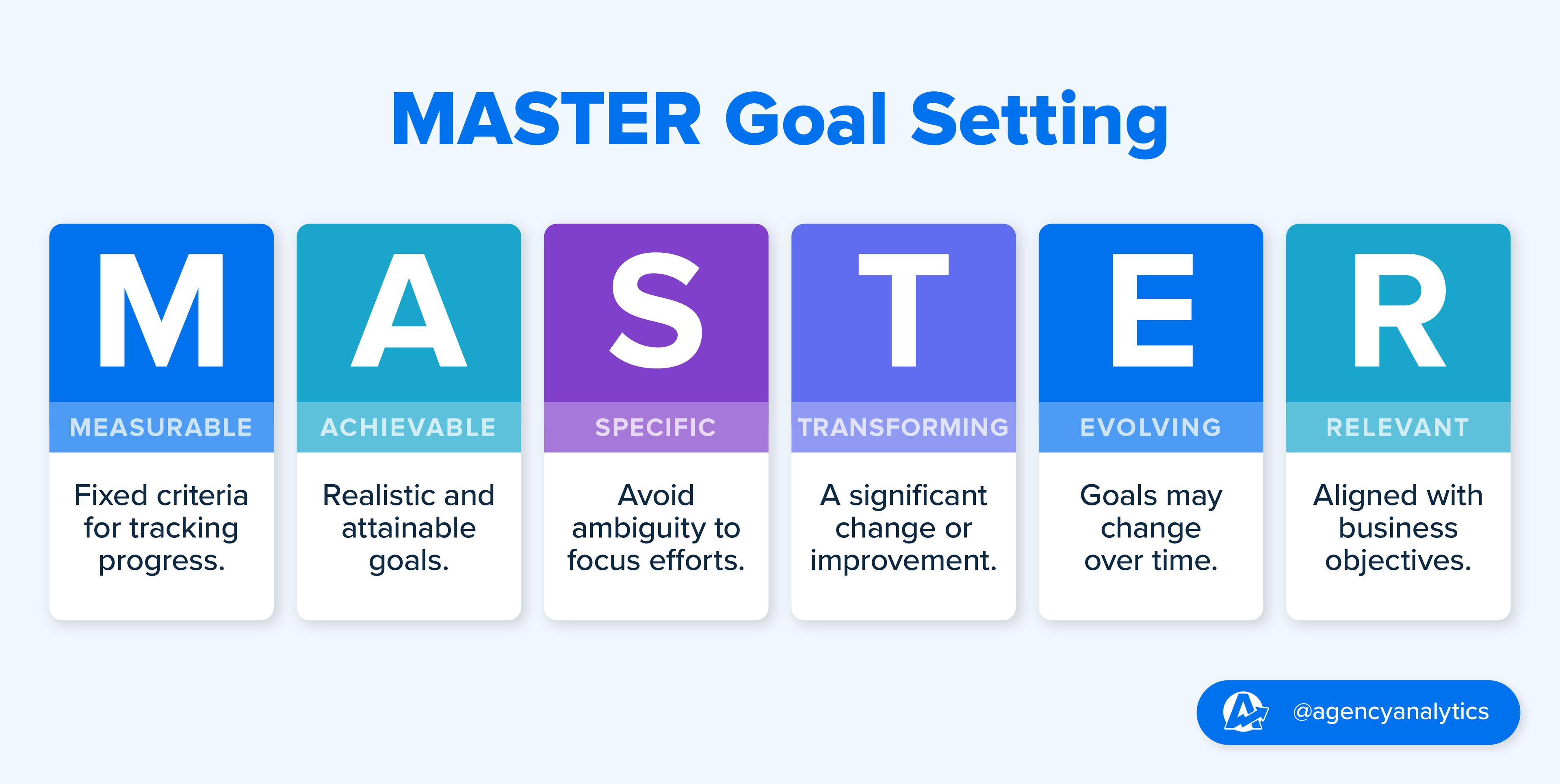
Define Key Performance Indicators (KPIs) Based on Client Goals: For example, if the objective is to boost conversions, relevant KPIs might include form submission rates, cost per acquisition (CPA), and return on ad spend (ROAS).
Use Industry Benchmarks: To set realistic targets, look to competitors and industry peers for data on where your clients’ goals should net out.
Looking for some up-to-date industry benchmarks? These articles might help!

Use AgencyAnalytics’ goal-tracking features for your clients as well as your agency. Get started with a 14-day free trial.
2. Collect Accurate, High-Quality Data
Data-driven marketing only works when you have reliable data. Poor data quality—such as outdated contact lists, duplicate records, or fragmented customer information—leads to misguided decisions and wasted ad spend.
Best Practices for Reliable Data Collection
Here are some tips to collect data that’s accurate and reliable.
Prioritize First-Party Data: Rely on data directly from clients’ websites, CRM platforms, and email marketing interactions rather than third-party sources that may soon be obsolete.
Break Down Data Silos. Marketing, sales, and customer support teams should share a centralized data hub rather than storing information in separate platforms that don’t communicate with each other.
Use Customer Data Platforms (CDPs) to unify customer information across all touchpoints, providing a complete view of the customer journey.
Validate Data Regularly. Set up processes to clean, de-duplicate, and verify customer data to avoid outdated or misleading insights.
3. Analyze Data for Actionable Insights
Data collection is just the first step—the real value comes from data analysis and interpretation. Your team must be able to identify trends, extract insights, and turn raw numbers into strategic marketing decisions.
Use Predictive Analytics: To anticipate future trends, optimize ad spend, and refine targeting strategies.
Monitor Conversion Paths: To identify where users drop off in the sales funnel and optimize touchpoints accordingly.
Compare Against Industry Benchmarks: To understand whether client performance is above or below expectations.
For more tips on data analysis, read this article: How To Analyze Marketing Data For Your Clients in 5 Steps.
4. Transform Data Into Meaningful Reports
Having large datasets is useless if clients don’t understand the insights. A strong reporting strategy focuses on clarity, data storytelling, and actionable recommendations rather than just presenting a pile of numbers.
We always support data with narrative elements. Many of our clients are extremely creative, so ensuring there are both visual and narrative elements is vital to all client engagements. We balance this by providing shorter narrative elements with technical data, highlighting the key parts clients need to read/understand rather than huge explanations.
Tom Gibson, Founder, Pilot
For more effective reporting:
Connect Metrics to Business Outcomes: Instead of simply showing “website traffic increased,” explain that higher traffic led to a 20% increase in qualified leads.
Use Data Visualization: Create charts, graphs, and heatmaps to make complex data easier to digest.
Create Customized Dashboards: Tailor dashboards to each client’s priorities rather than overwhelming them with irrelevant metrics.
Provide Actionable Takeaways: Highlight what’s working, what’s not, and what to do next.
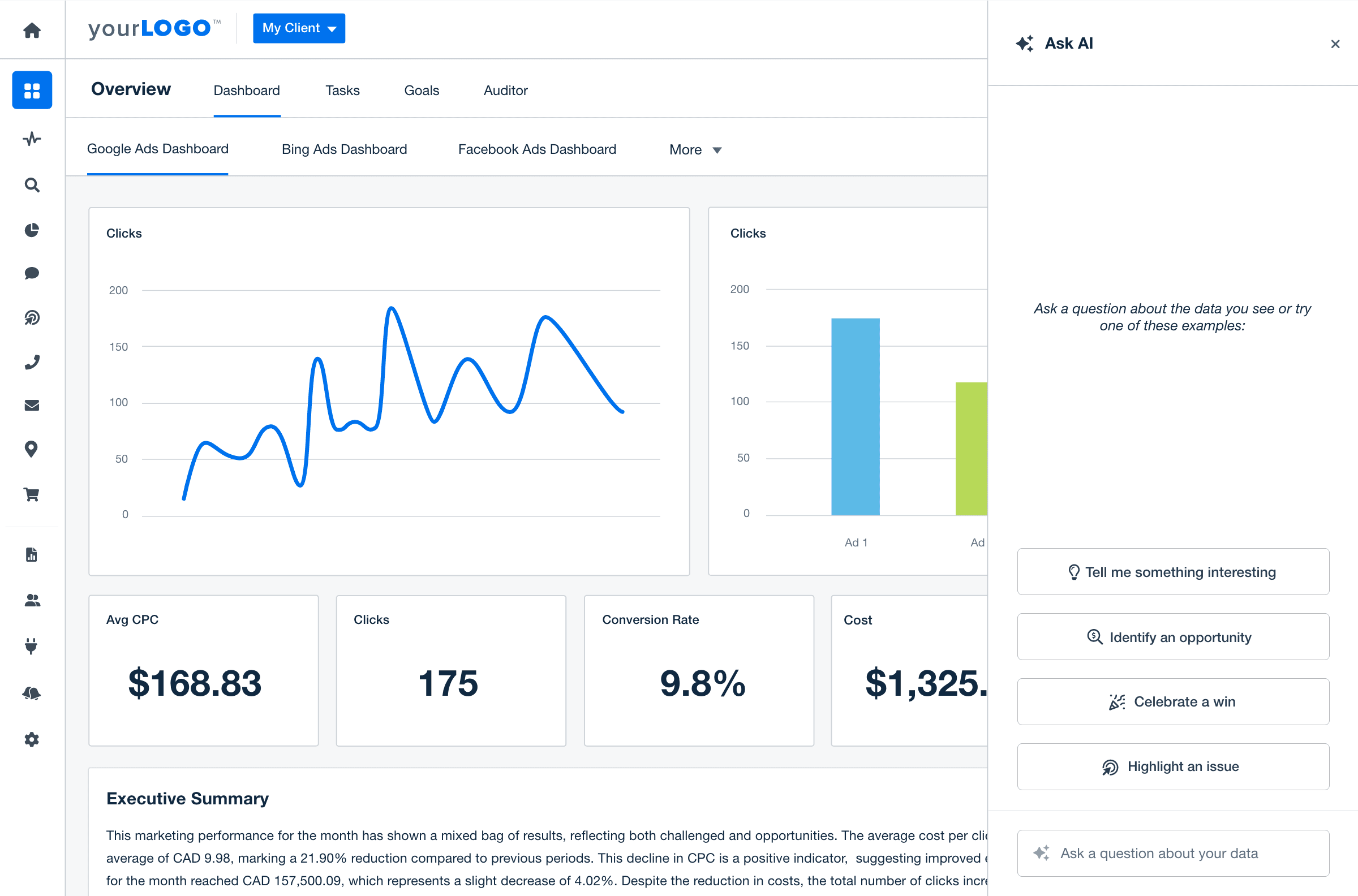
With AI-powered insights, automated reporting, and live dashboards, AgencyAnalytics helps you save time, identify trends, and surface critical findings. Try it yourself with an AgencyAnalytics 14-day free trial.
5. Follow Data Privacy Compliance Laws
As data privacy laws evolve, your marketing team must ensure they collect and store data ethically and legally. Non-compliance can result in hefty fines and lost client trust.
Key Privacy Laws & Best Practices:
GDPR (Europe): Requires user consent before collecting personal data and mandates transparent data policies.
CCPA (California): Gives consumers control over how their data is collected, used, and sold.
Other emerging laws are Virginia’s CDPA, Canada’s PIPEDA, and Brazil’s LGPD, all with unique requirements that agencies must track.
Implement Privacy-Friendly Tracking Methods such as server-side tracking and consent management platforms (CMPs).
Agency Tip: Regularly review clients’ privacy policies and data collection practices to ensure compliance as new regulations emerge.
6. Experiment and Iterate
Data-driven marketing is an ongoing process, not a one-time setup. You must continuously analyze data, test new approaches, and refine strategies based on real-time insights. Here are a few ways to regularly optimize your marketing campaigns to ensure a continuous feedback loop:
A/B Test Ad Creatives, Landing Pages, and Messaging: To improve performance.
Use Real-time Analytics: To adjust campaigns dynamically instead of waiting until the end of a reporting period.
Monitor Cross-Channel Attribution: To understand how different marketing efforts contribute to conversions.
Refine Media Mix Modeling: To optimize where marketing dollars are spent for maximum impact.
3 Data-Driven Marketing Examples for Inspiration
Now, let’s review a few scenarios to portray how you might tackle them using data-driven marketing.
1. Optimizing Website Content for Search Intent
Let’s say you intend to do some data analysis to determine how to strengthen a client’s website content. To understand how well the site is performing, you would use marketing analytics tools to track key website performance KPIs, including:
By comparing these KPIs to industry benchmarks, you get a better idea of where your client stands. Are they outperforming competitors or struggling in key areas?
Let’s take bounce rate, for example. A high bounce rate means visitors are landing on a page and leaving without taking further action. This could indicate:
A mismatch between user intent and content (e.g., visitors expect a product page but land on a blog post).
Slow page load times driving users away before they even engage.
Poor content structure making it hard for visitors to find what they need.
Lack of internal links guiding users to other relevant pages.
Once you’ve identified if a high bounce rate is an issue, you’re then able to confidently recommend the following strategies to improve website content and engagement:
Refine Keyword Targeting: Ensure that keywords align with search intent. If users expect a product page but land on a blog post, they’re likely to leave.
Enhance Content Relevance: Ensure page titles, headings, and meta descriptions accurately reflect the content so users find what they expect.
Add Internal Links: Guide visitors to related content and encourage them to explore more pages on the site.
Optimize for Mobile: Use responsive design and test page performance on mobile devices to ensure a seamless experience.
Improving these areas leads to lower bounce rates, longer sessions, and higher conversions—all key indicators of a well-optimized website that delivers value.
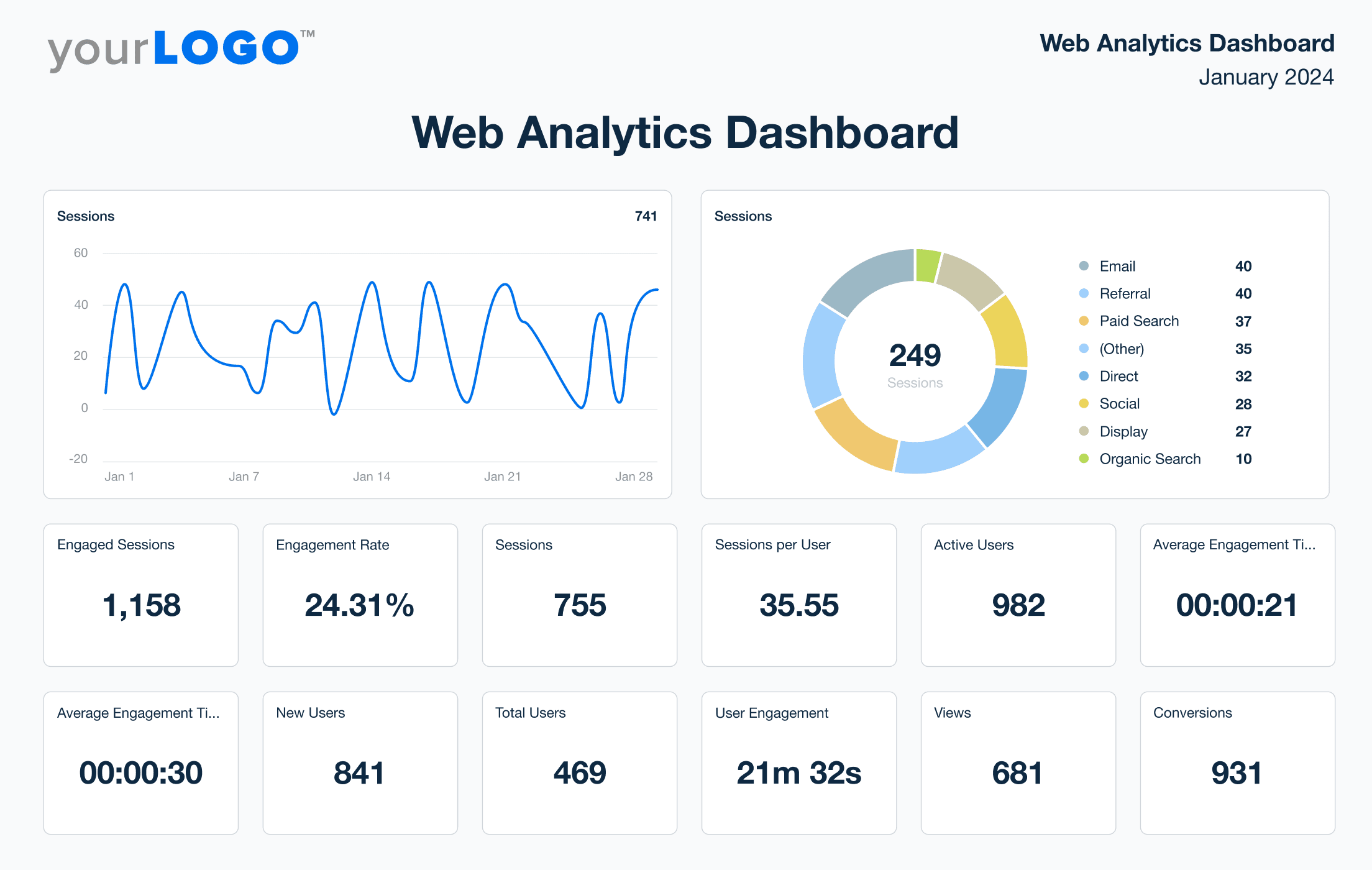
Combine data from Google Analytics, Matomo, and 80+ digital platforms in a single, powerful web analytics dashboard. Gain real-time user insights and optimize content for maximum impact. Start your 14-day free trial.
2. Using Audience Analytics To Refine Targeting
If you’re attracting the wrong audience, conversion rates will suffer—no matter how great the content or offer. To maximize engagement and conversions, you need to know exactly who is interacting with your client’s brand.
Audience analytics provide critical insights into demographics, behaviors, and preferences—allowing you to fine-tune targeting, messaging, and ad spend for better results.
Understanding this relevant data will help you assess whether you're reaching the right audience:
Demographics
Interests & Affinities
Traffic Sources
New vs. Returning Visitors
Behavior Flow
Ad Engagement & Click-Through Rates (CTR)
A social media dashboard with data visualization tools helps you analyze demographic data quickly, such as age ranges, top countries, top cities, and languages for each social platform you're using.

These insights then inform targeting decisions and tactics like:
Segmenting the Audience: Group users based on behavior, interests, and demographics to create more effective marketing campaigns.
Tailoring Messaging & Offers: Use audience data to craft content that addresses their pain points, needs, and preferences.
Optimizing Ad Targeting: Use lookalike audiences and retargeting ads to reach high-intent prospects similar to your best-performing customers.
Testing and Iterating: A/B test different creatives, messaging, and CTAs to see what resonates most with specific audience segments.
Fine-tuning your targeting based on audience data ensures higher engagement, stronger conversions, and better ROI—all while eliminating wasted ad spend on the wrong audiences.
3. Leveraging Location Data for a Localized Marketing Strategy
A one-size-fits-all approach won't cut it if a significant portion of your client’s audience is concentrated in a specific region. Localized marketing allows you to tailor messaging, offers, and ad spend to specific geographic areas.
To determine where to focus your marketing efforts, monitor these geo-location analytics:
Top Performing Locations
Regional Conversion Rates
Local Search Traffic
In-Store Visits (if applicable)
Ad Performance by Location
A local SEO dashboard streamlines this process by centralizing geo-location analytics. It makes it easy to track trends, compare regional performance, and adjust strategies in real-time without digging through multiple platforms.
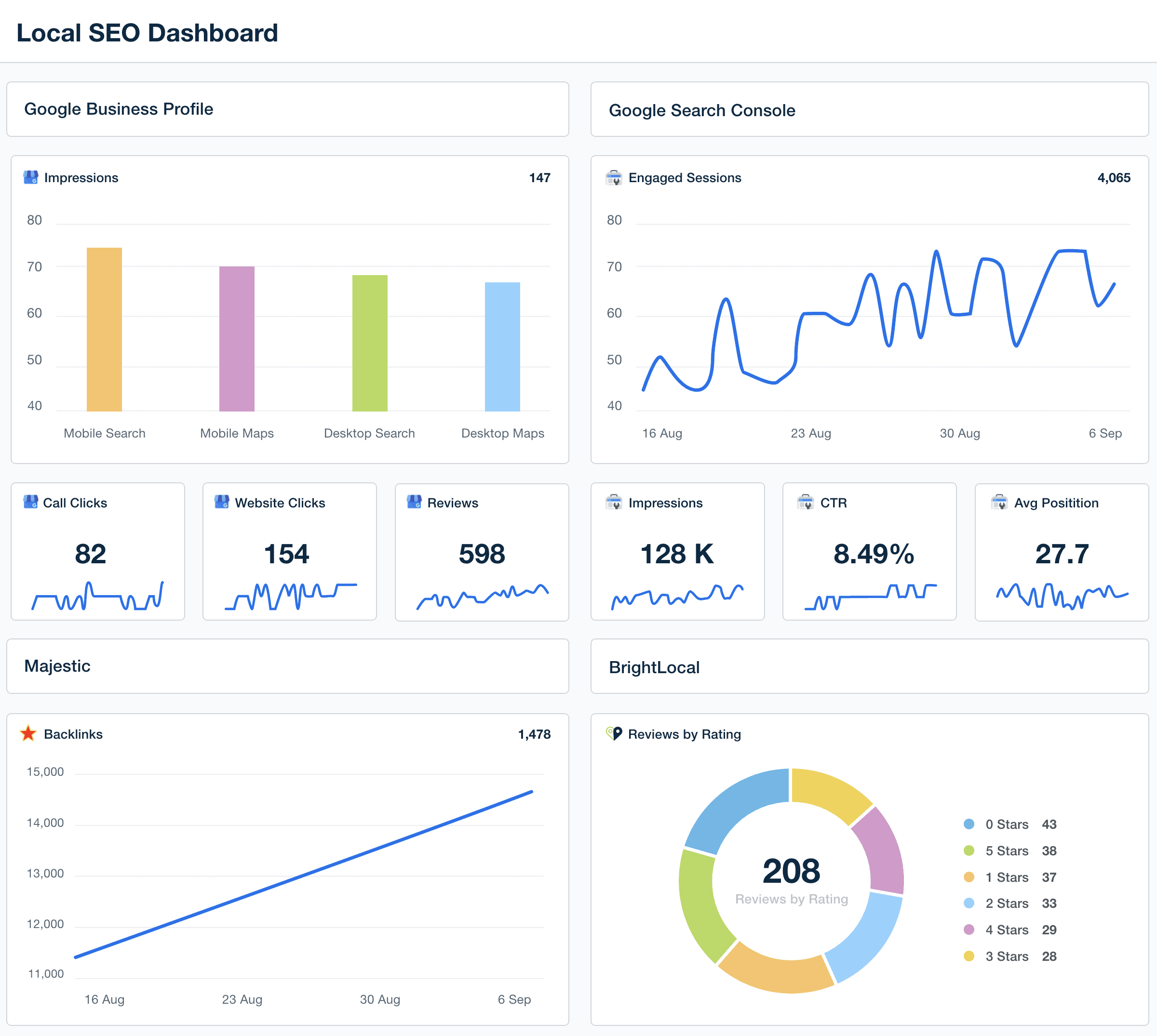
Once you’ve identified high-value geographic regions, you’ll be able to recommend these strategies to refine your localized marketing activities:
Adjust Ad Targeting: Run geo-targeted PPC and social media ads, prioritizing high-converting locations while reducing spend in low-performing areas.
Personalize Messaging by Region: Tailor content, offers, and promotions to reflect regional preferences, cultural nuances, or seasonal trends.
Leverage Local Influencers & Partnerships: Collaborate with regional influencers, businesses, or events to increase brand credibility and awareness.
A data-driven, localized approach ensures you focus on marketing activities with the greatest impact.
Data-Driven Marketing Works
Marketing agencies face a clear choice: operate on guesswork and intuition or harness the power of data.
Data isn’t just numbers in a dashboard; it’s a roadmap to smarter decisions, deeper customer understanding, and more profitable campaigns. It’s the difference between running ads and running ads that convert, between creating content and creating content that resonates, and between spending marketing dollars and investing them wisely.
The agencies that embrace data aren’t waiting for success—they’re engineering it. They’re identifying trends before competitors, testing strategies with precision, and optimizing every touchpoint in the customer journey. They’re proving their value with clear, undeniable results.
So, what’s your agency’s next move? Will you continue to rely on gut feelings, or will you start leveraging real-time insights to refine your marketing strategies and drive stronger results?
The answer is in your data. Use it!

Written by
Sylva is an expert content writer with over 10 years of experience in tech and SaaS, offering first-hand insight into agency needs from her background in advertising.
Read more posts by Sylva SivzattianSee how 7,000+ marketing agencies help clients win
Free 14-day trial. No credit card required.




